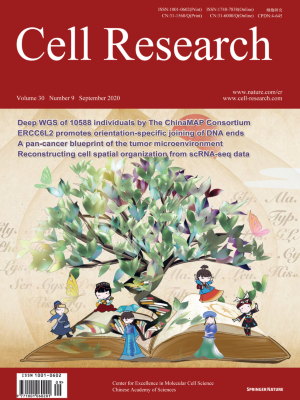
Volume 30, No 9, Sep 2020
ISSN: 1001-0602
EISSN: 1748-7838 2018
impact factor 17.848*
(Clarivate Analytics, 2019)
Volume 30 Issue 9, September 2020: 810-813 | Open Access
LETTERS TO THE EDITOR
Generation of human hepatocytes from extended pluripotent stem cells
Qiming Wang1, Da Sun 1,2 , Zhen Liang2, Junyi Wang1,Xinxing Zhong 1,2 , Yulin Lyu3, Junning Cao4, Zhongqing Lin5,Yuanyuan Du 1,6 , Zhenchuan Miao5, Shichun Lu4, Cheng Li3,Jun Xu1, Yan Shi1 and Hongkui Deng 1,2
1 School of Basic Medical Sciences, State Key Laboratory of Natural and Biomimetic Drugs, Peking University Health Science Center and the MOE Key Laboratory of Cell Proliferation and Differentiation, School of Life Sciences, Peking-Tsinghua Center for Life Sciences, Peking University, 100871 Beijing, China; 2
State Key Laboratory of Chemical Oncogenomics, School of Chemical Biology & Biotechnology, Peking University Shenzhen Graduate School,Shenzhen 518055 Guangdong, China; 3School of Life Sciences, Center for Bioinformatics, Center for Statistical Science, Peking University, 100871 Beijing, China; 4Department of Hepatobiliary Surgery, The First Medical Center, Chinese PLA General Hospital, 28 Fuxing Road, Haidian, 100853 Beijing, China; 5Beijing Vitalstar Biotechnology Co.,Ltd, 100000 Beijing, China and 6Hangzhou Repugene Technology Co., Ltd, Hangzhou 311121 Zhejiang, China
These authors contributed equally: Qiming Wang, Da Sun, Zhen Liang
Correspondence: Jun Xu (jun_xu@bjmu.edu.cn) or Yan Shi (shiyan@bjmu.edu.cn) or Hongkui Deng (hongkui_deng@pku.edu.cn)
Human pluripotent stem cells have great potential for application in regenerative medicine, as they permit the generation of different lineages of functional cell types via directed differentiation.1 However, application of conventional human pluripotent stem cells is limited due to several factors, including heterogeneity in pluripotency, differentiation bias, relatively slow proliferation, and poor single-cell survival.2 To overcome these problems, extensive efforts have been made in recent years, including optimizing the culture conditions of conventional human pluripotent stem cells3 and deriving new human pluripotent cell types such as naive human pluripotent cell lines.1 Recently, our group established a new type of pluripotent stem cells designated as extended pluripotent stem (EPS) cells,4 which have both embryonic and extraembryonic developmental potential. Compared to known pluripotent stem cell types, these cells have superior differentiation potential, as demonstrated by single-cell chimeric assays in vivo. Furthermore, EPS cells can be long-term expanded through single-cell passaging with a high proliferation rate. These unique features of EPS cells make them valuable in biomedical applications, such as gene targeting and animal model generation.5,6 In particular, it is promising to apply human EPS cells in directed differentiation but has not yet been explored. In this study, we sought to use human EPS cells in directed differentiation by generating human hepatocytes from these cells. Our group has made great efforts in establishing directed differentiation protocols for generation of human functional hepatocytes from conventional human pluripotent stem cells.7,8,9 In this work, we demonstrated that human EPS cells could be efficiently differentiated into functional hepatocytes (EPS-Heps) through adding a pretreatment step before hepatic differentiation. Importantly, compared to hepatocytes derived from conventional human pluripotent stem cells, EPS-Heps transcriptionally more resemble primary human hepatocytes.
Cell Research advance online publication 20 Jun 2006; doi: 10.1038/sj.cr.7310078
FULL TEXT | PDF
Browse 1390


